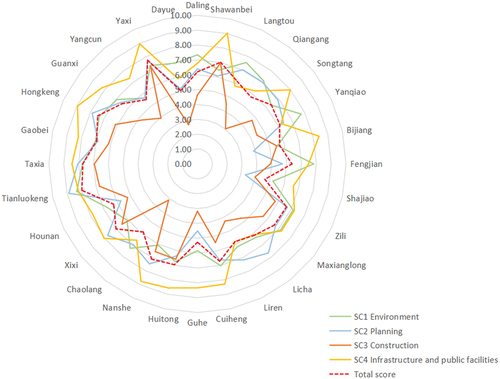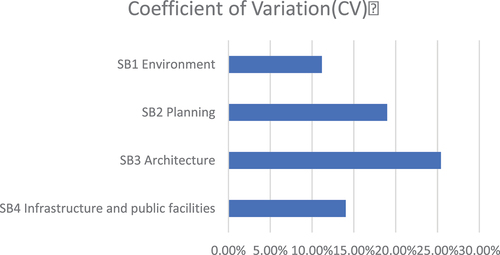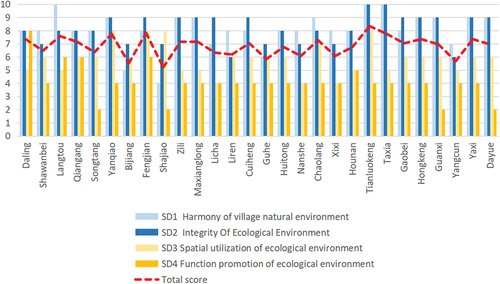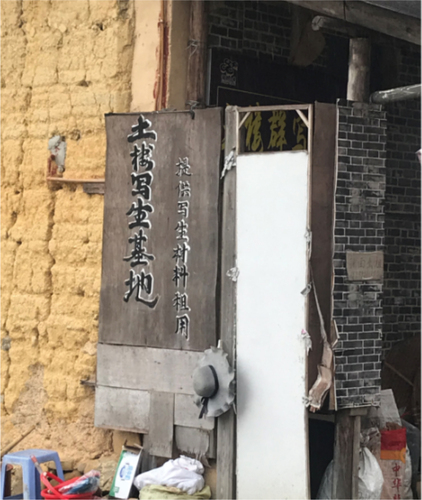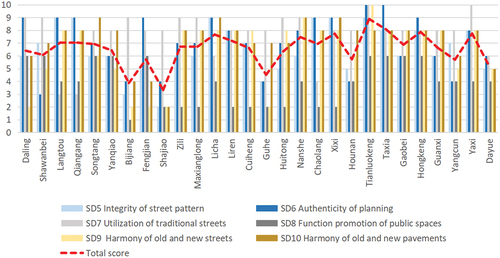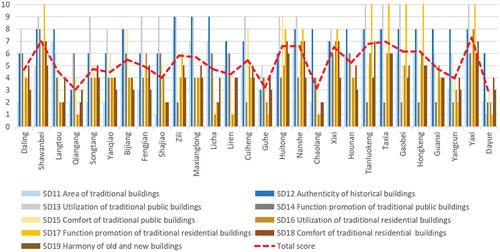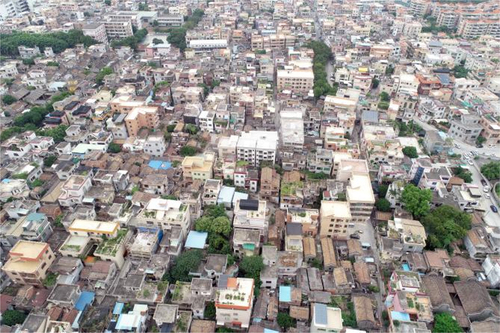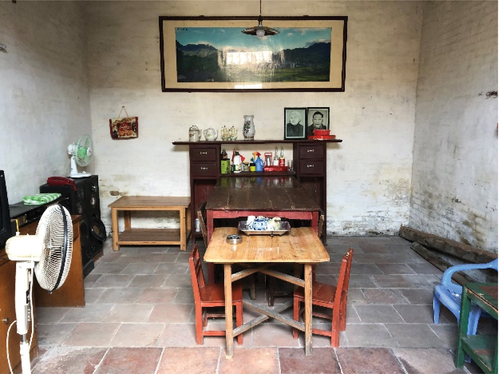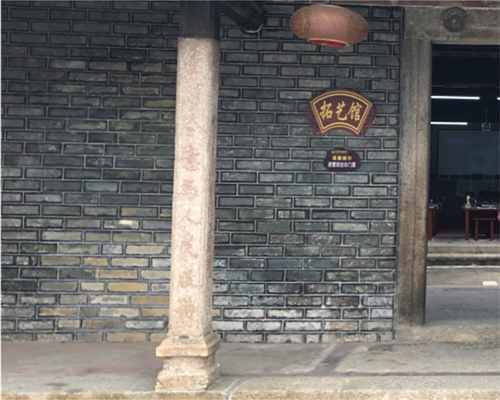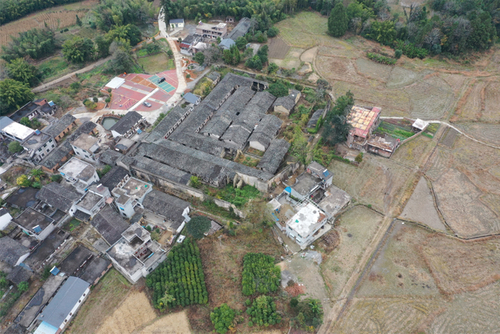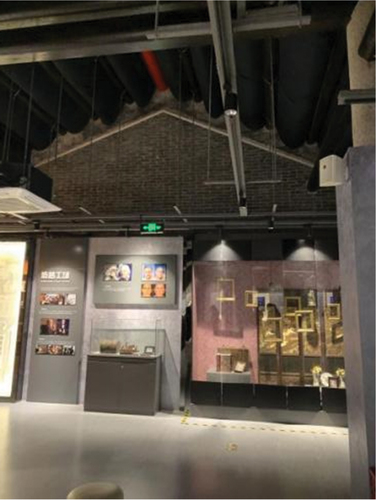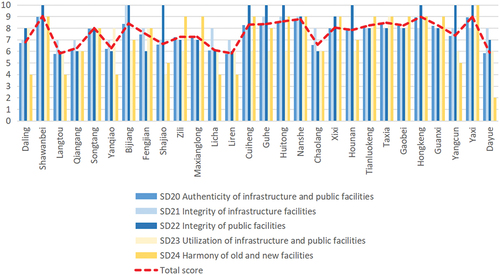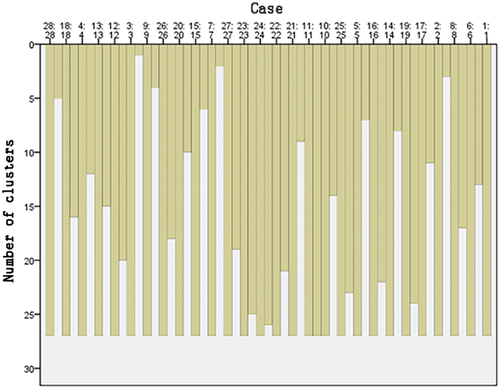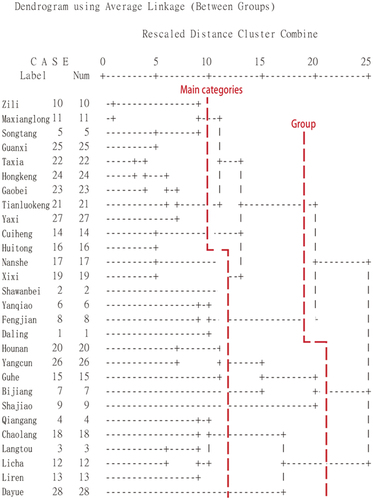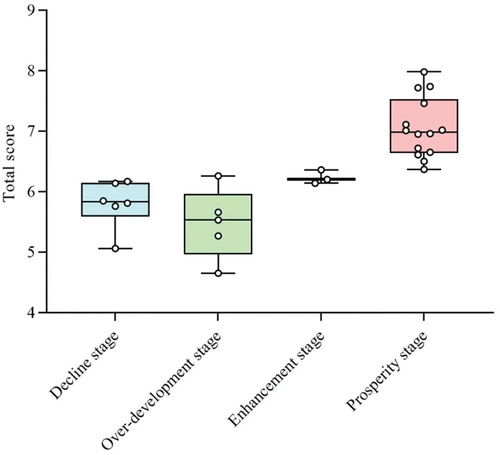 ?Mathematical formulae have been encoded as MathML and are displayed in this HTML version using MathJax in order to improve their display. Uncheck the box to turn MathJax off. This feature requires Javascript. Click on a formula to zoom.
?Mathematical formulae have been encoded as MathML and are displayed in this HTML version using MathJax in order to improve their display. Uncheck the box to turn MathJax off. This feature requires Javascript. Click on a formula to zoom.ABSTRACT
In China, despite the continuous efforts to preserve traditional villages in recent years, a significant amount of cultural heritages continue to vanish. Commonly observed issues such as the lack of coordination between preservation and development, the imbalance in spatial environment conservation and utilization, are pervasive. Regrettably, there is a conspicuous absence of theoretical underpinning in addressing these challenges. In this study, The evaluation factor of spatial environmental protection was selected, and these factors were weighted through expert surveys and the Analytic Hierarchy Process, and applied the multi-objective linear weighting function method to obtain a comprehensive evaluation calculation formula. Subsequently, we conducted an assessment of 28 representative traditional villages in the southern Chinese regions of Guangdong, Fujian, and Jiangxi. Their current issues were systematically analyzed and cluster analysis was applied to discern 11 distinct typologies of traditional village development. Besides, the temporal evolution patterns of these villages were delved into, and their development were categorized into five stages: initiation, enhancement, prosperity, over-development, and decline. Ultimately, based on the spatial environment characteristics of each development type and evolution stage, corresponding guidelines for spatial environment conservation and utilization are proposed, which provides necessary theoretical frameworks for future work this region.
1. Introduction
Traditional villages could be regarded as a reflection of local traditional culture, architectural art, and folk custom. The spatial environment of these villages serves as the tangible carrier of cultural heritage, possessing a significant value of the active history. However, in China, the impact of modern lifestyle and urban population concentration has led to a gradual decline in the population of traditional villages, with traditional buildings being sparsely inhabited and utilized. As a result, numerous traditional villages are rapidly disappearing, which urgently necessitates the rescue and preservation (Cao et al., Citation2013). In the past decades, various levels of government have allocated substantial resources to protect traditional villages, yet traditional buildings steady decline, and the gradual disappearance of cultural heritages remains a challenging problem. The management of many traditional villages primarily relies on experience and exploration, lacking theoretical methods and management approaches for the preservation and development, thereby delaying the conservation process. To address this issue, it is essential to categorize preservation and development of traditional villages into different stages and types, and formulate corresponding preservation measures and development strategies. Thus, the vast number of traditional village administrators could receive a better technical support and management basis.
Over the past decade, the focus of research on traditional villages has gradually shifted from “preservation” (Zhang et al., Citation2021) to “preservation and development” (Xiangbin and Quan, Citation2022, Wei et al., Citation2022, Su and Song, Citation2022, Xu, Citation2022, Huang and Tian, Citation2021, Wang et al., Citation2020, Shi and Wang, Citation2021). This shift underscores that the contemporary issues are no longer limited to heritage preservation alone but encompass a dual emphasis on preservation and development. Discussions regarding strategies for the preservation and development of traditional villages have largely been approached from the perspective of planning and design for individual cases. These approaches analyze the spatial morphology of villages and propose comprehensive planning strategies and technical routes (Zhou and Zheng, Citation2022, Wang et al., Citation2020, Rong and Liu, Citation2020, Park et al., Citation2008). Besides, various perspectives have been explored, including catalytic intervention (Chen et al., Citation2022), rural complex construction (Wu et al., Citation2022), red culture (Xiang et al., Citation2022), clan culture (Chen et al., Citation2022), tea culture (Wu, Citation2021), cultural ecology (Li, Citation2021), tourism development (Zhang, Citation2022), cultural creativity (Wen, Citation2020), coordination of the three life spaces (Liu et al., Citation2021), community building (Lin, Citation2022), and villagers’ subjectivity (Shi and Cheng, Citation2023), each offering planning and design methods aimed at revitalizing protection by enhancing village characteristics, incorporating cultural elements, and strengthening community self-governance. This direction towards “dynamic” protection methods has gained consensus (Zhang, Citation2022). While the examination of typical case studies can provide valuable insights for other villages, a systematic classification of village resource types can offer a more structured approach to guide village development. Huang (Citation2022), for instance, employed typology and evaluation methods to explore industrial development strategies for 14 villages in the Guangdong-Foshan region of China (Deng et al., Citation2022). Additionally, a correlation analysis of management mechanisms and conservation and utilization performance was conducted, which resulted in the proposal of optimized management strategies (Liu et al., Citation2022).
Numerous scholars have employed typological approaches to study traditional villages, categorizing different types of villages from various perspectives. Classification criteria include geographic location, village value, preservation and development status, etc. Classification methods of the quantitative research on traditional villages include the Analytic Hierarchy Process (AHP), Delphi method, and factor analysis (Yu et al., Citation2021, Peng, Citation1992, Lü and Yang, Citation2016, Chen and Fang, Citation2021, Kong et al., Citation2021, Wang, Citation2014, Xiang et al., Citation2015). Zhang (Citation2020) classified the space of traditional villages into material space and non-material space based on spatial form differences (Zhang, Citation2022), while Chen (Citation2019) divided the key identities of traditional villages in Huangshan City into five categories: historical accumulation, village environment, layout and style, traditional buildings, and folk culture (Chen et al., Citation2019). Pan (Citation2022) measured the vitality of four traditional villages in Yongzhou, Hunan Province, classified as tourism development-oriented, traditional craftsmanship-oriented, comprehensive development-oriented, and life service-oriented (Pan et al., Citation2022). In Zhan’s 2022 study, an examination was conducted from the perspective of kernel density to assess the spatial distribution patterns and resource types of the National Rural Tourist Towns in China (Zhan et al., Citation2022).
As for the study of the development stages of traditional villages, Chinese scholars have suggested that their developmental conditions within the same region may be different (Wang, Citation2014). Some studies have listed the implementation stages of conservation and utilization for traditional villages. For instance, Liu (Citation2014) detailed the key tasks for the short-term, medium-term and long-term implementation of traditional village planning in her doctoral dissertation (Liu and Xiao, Citation2014), while Huang (Citation2016) divided the implementation stages of preservation planning into pre-implementation, mid-implementation, and post-implementation phases. The mid-implementation phase was further categorized into initial, developing and stable periods (Huang, Citation2016). Through visits to traditional villages, it was observed that some villages with worse current conditions initiated preservation measures early, but due to poor results, the preservation was of no lasting efforts, resulting in a declining state. During the conservation and utilization process, each period of improvement will eventually reach a relatively stable state but may also encounter new problems, demonstrating a cyclical pattern of “improvement – emergence of new issues.” This indicates a gradual and progressive process. The conditions and issues at each stage exhibit similar characteristics, which should be summarized and generalized; however, the specific division of these stages remains unresolved.
In summary, previous research has mainly focused on studying issues of spatial environment from individual villages, with limited research on widely applicable problems of the common cases. There has been a greater emphasis on analyzing aspects of spatial environment in an isolated situation, while systematic summary has been lacking. Discussions have primarily centered around universal problems without specific categorization of different development stages and types, and there has been little exploration of protective measures tailored to different types of traditional villages.
This study aims to address the issues of the discordance between traditional village preservation and development, uneven performance in spatial environment conservation and utilization, and ambiguity in the implementation measures of different stages. To achieve this, we establish an evaluation system for spatial environment conservation and utilization. We rate 28 representative traditional villages in the Guangdong, Fujian and Jiangxi regions, summarize the existing problems, and utilize cluster analysis to classify them into different development types and evolution stages. Based on the spatial environment characteristics of each development type and evolution stage, corresponding guidelines for spatial environment conservation and utilization are proposed.
2. Research methods
We selected villages located in the adjacent provinces of Fujian, Guangdong, and Jiangxi as our research samples. These villages share similar climatic conditions and cultural identities. The Post Occupancy Evaluation (POE) method was applied to conduct the analysis, which involves the following steps: establishing an evaluation framework, conducting on-site investigations, scoring, and performing mathematical and statistical analyses.
2.1. Case selection
28 representative and typical villages has been selected from the Guangdong, Fujian, and Jiangxi provinces as evaluation samples (). The field research was conducted between September 2020 and February 2021.
2.2. Evaluation factors
Based on the preservation planning and design, evaluation theory, and on-site visits to traditional villages, we examined the changes after the implementation of conservation and utilization measures. The spatial environment was summarized into four aspects: environment, planning, architecture, and infrastructure and public facilities. Considering the potential issues related to planning implementation, function promotion, space utilization, and the coordination of old and new elements in each aspect, we eventually established a three-level evaluation system with 2 primary factors, 4 secondary factors, and 24 tertiary factors for assessing the performance of spatial environment conservation and utilization in traditional villages ().
Table 1. Performance evaluation system and factor interpretation of spatial environment conservation and utilization in traditional villages.
2.3. Data collection
Data collection involved various methods, including literature review and analysis, interviews, questionnaire surveys, on-site inspections, and measurements. Data came from official statistics released by various levels of government, local village application materials, and historical records from local yearbooks. Besides, we collected Information about the landscape pattern, surrounding environment, current state of architectural preservation, files of village maintenance, intangible cultural heritages, local regulations and customs, etc. Interviews were conducted with village committee members to understand the processes and conditions of local conservation and utilization. This provided insight into the local preservation status, management models, funding and technical support, publicity and educational methods, and public participation. Additionally, interviews with village residents were conducted to understand their current living conditions, traditional customs, attitudes toward village preservation and development, and their satisfaction with the preservation outcomes and management agency.
2.4. Delphi method for weight determination
The Delphi method was employed to determine the weight factors. Initially, questionnaires were distributed to five experts regarding the primary factors, and their scores were averaged. After obtaining the weights of all primary factors, questionnaires were then distributed to the experts for the secondary factors. Through multiplying the relative weights of the secondary factors by their respective primary weights, the final weights of the secondary factors were obtained (). The algorithm for the geometric mean is as follows: assuming there are N experts, expert 1 gives a score of , expert 2 gives a score of
, and so on, with expert N gives a score of
. The calculation formula for the geometric mean is shown in Formula 1.
2.5. Evaluation criteria
The construction of evaluation criteria adopted a combination of qualitative and quantitative methods. For quantifiable factors such as the utilization rate of ecological environment and the integrity of street layout, efforts were made to quantify the criteria. For non-quantifiable factors such as the authenticity of planning locations and the harmony of old and new buildings, qualitative methods were used to establish standards. The scoring in the evaluation system used a 10-point scale to assign scores to each sample factor. Quantifiable indicators were classified into five quantity intervals based on quantities, sizes, and scales, and scored accordingly. Qualitative indicators were divided into five levels: “Excellent, Good, Moderate, Subpar, and Poor,” with corresponding scores assigned in a decreasing order, ”10–9 points, 8–7 points, 6–5 points, 4–3 points, 2–0 points.”
2.6. Multi-objective linear weighted function method
The multi-objective linear weighted function method was employed for the comprehensive evaluation of spatial environment in traditional villages, as expressed in Formula 2. In the formula, M represents the comprehensive evaluation score of the spatial environment; denotes the score of a specific index j;
is the weight of index j at the current level; and
represents the weight of the ith factor among the four primary factors.
2.7. Reliability analysis
To assess the reliability of expert scores for various factors of each village, SPSSAU software was used for statistical analysis. The results indicated that the Cronbach α coefficients for all dimensions were greater than 0.800 (), suggesting that the village scores exhibited high reliability and were suitable for further statistical research.
Table 2. Reliability analysis.
2.8. Cluster analysis
Hierarchical clustering was performed on the Data Set at different levels to form a tree-like cluster structure. The average distance method was used to calculate the distance between clustering clusters Ci and Cj:
3. Performance evaluation of spatial environment conservation and utilization in traditional villages
3.1. Overall evaluation results
The scores of primary and secondary factors for each village are shown in .
From the radar chart () and coefficient of variation chart (), it can be observed that three factors, namely, environment, planning, and infrastructure and public facilities, had larger areas than the total score area, with infrastructure and public facilities performing the best. The score area for the architecture factors was smaller than the total score area, and the coefficient of variation was relatively high, indicating that the architecture conservation and utilization in the sample villages lagged behind, and showed uneven performance. Among the architecture factors, “authenticity of historical buildings” and “utilization of traditional public buildings” were relatively good, while “area of traditional buildings”, “utilization of traditional residential buildings” were generally moderate. However, “function promotion of traditional public buildings”, “comfort of traditional public buildings”, “utilization of traditional residential buildings”, “function promotion of traditional residential buildings”, “comfort of traditional residential buildings” remained many problems, and “harmony of old and new buildings” was generally poor. It indicated that “function promotion of traditional public buildings” and “utilization of traditional residential buildings” were weak points. The two villages with the highest total scores were Tianluokeng Village, which performed the best in terms of environment and planning, and Yaxi Village, which excelled in architecture and infrastructure and public facilities.
3.2. Sub-item evaluation results
3.2.1. Environment
From the scoring results of the environmental factors in , it can be observed that the l variation in the total scores among the villages was relatively small. Tianluokeng Village obtained the highest score, with 8.34, while Shatou Community had the lowest score of only 5.21. The two factors, “harmony of village natural environment” and “integrity of ecological environment”, received relatively high scores across all villages. However, the scores for the factors “spatial utilization of ecological environment” and “function promotion of ecological environment” were generally poor, with significant variations among the villages. The “spatial utilization of ecological environment” refers to the proportion of natural and agricultural landscape utilization, while the “function promotion of ecological environment” represents the presence of new functions in natural and agricultural landscape. The results indicate that while the villages excelled in preserving the ecological environment, the aspect of utilization needs improvement.
Tianluokeng Village, situated in the mountains with undulating terrain and terraced field landscapes, is well-known for the layout of Hakka Soil Buildings. It has constructed an observation deck at a high point where visitors can admire the terraced fields and architectural landscapes, making it a popular spot for tourists to take photos (). Both Tianluokeng Village and Taxia Village have established Art bases within their villages, providing rental services for art enthusiasts who come for sketching and painting ().
3.2.2. Planning
From the scoring results of the planning factors in , it can be seen that there is a considerable difference in total scores between the villages. Tianluokeng Village received the highest score of 8.88, while Shatou Community obtained the lowest score of 3.32. Apart from the “function promotion of public spaces,” which was notably lower than the overall score, the scores for other factors fluctuated around the overall score. The “function promotion of public spaces” and the “harmony of old and new streets” showed a relatively large coefficient of variation, indicating significant fluctuations in their scores.
Some villages, such as Songtang Village, Yanqiao Village, and Dalin Village, still have visible traditional street layouts, although the comb-style layout of Guangfu is disappeared in certain areas. Shatou Community and Bijiang Community had the overall poorest street layout conditions. While some traditional street layouts were still discernible, they have been significantly affected by the construction of new buildings, resulting in substantial damage and even destruction. Regarding the “function promotion of public spaces”, most villages were rated as moderate, except for Dalin Village, Fengjian Village, and Yanqiao Village, which performed relatively well due to their emphasis on the Dragon Boat culture, resulting in enhanced public spaces with functions related to cultural festivals. Other villages, such as Shawan North Village, Tianluokeng Village, Taxia Village, Gaobei Village, and Hongkeng Village, have seen a corresponding enhancement of public spaces due to their tourism development, such as the “Hakka Soil Building Fashion Week,” etc. Yaxi Village has developed a dance performance that incorporates local customs, adding new functions to its public spaces. Some villages, such as Chaolang Village, Zili Village, Lichao Village, and villages with Hakka Soil Buildings, which are well-preserved, have been used as locations for filming movies and documentaries.
3.2.3. Architecture
From the scoring results of the architectural factors in , it can be observed that there is a significant difference in total scores between the villages. Yaxi Village obtained the highest score of 7.28, while Dayue Village had the lowest score of 2.70. Two factors, “authenticity of historical buildings” and “area of traditional buildings”, received relatively high scores across all villages. However, there was considerable variation among the villages regarding “function promotion of traditional residential buildings.” On the other hand, the rate of “comfort of traditional residential buildings” and “harmony of old and new buildings” showed minor variations.
Due to strict limitations on the permission of lands for new constructions in the villages, many villagers resort to demolishing old buildings for new ones or adding extensions to meet their housing needs. For example, in Hongkeng Village, some exterior walls of Hakka Soil Buildings were repaired with concrete materials, and even punctured by big openings on the ground floor to create storefronts (). The new buildings often conflict with traditional architectural styles in terms of height, color, and size. In Bijiang Village, new homesteads have an area of only 80 square meters, smaller than most sites of old dwellings. As the villagers are unwilling to move out and unable to apply for government funds to maintain the old buildings, it is common to use inexpensive construction techniques to repair or expand the traditional dwellings ().
Apart from Shawan North Village, Fengjian Village, Zili Village, Cuiheng Village, Nanshe Village, Xixi Village, Huitong Village, Yaxi Village, and some well-developed villages with Hakka Soil Buildings, other villages are facing a significant hollowing-out phenomenon and a disappearance of traditional buildings. Since the scale and function of traditional buildings no longer meet the current needs of the villagers, many people moved away to build new houses, leaving traditional dwellings vacant or in ruins. Even those still used for habitation were mostly housed in the elderly. The spatial layout of traditional dwellings fails to meet modern usage demands. Traditional dwellings are characterized by closed spatial patterns, outdated sanitary facilities, and heavy colors in materials such as brick walls, making them unsuitable for modern open living patterns and facility needs (). Besides, improper renovation of traditional buildings has led to constructive damage. Using traditional construction techniques in the repair work requires significant funding, which many villagers cannot afford. As a result, modern building materials and construction methods were utilized to renovate some traditional buildings, leading to a rough craftsmanship or constructive damage.For example, the restored walls of Hou Nan Village have lost the authenticity and heritage value of traditional architecture ().
The lack of coordination between the demands of the villagers and the regulations of management stagnates the preservation of many traditional dwellings, and a large number of buildings are facing the danger of collapse. For instance, in Dayue Village, the villagers spontaneously raised funds to repair the enclosed houses which partially collapsed. However, the repair process and techniques did not comply with the management regulations, resulting in the project being halted. The government was unable to allocate sufficient preservation funds in a short period of time, leaving the enclosed houses exposed to the threat of natural deterioration ().
In most villages, traditional public buildings are open for exhibition, and additional commercial functions were therefore equipped. In Daying Village, Xian Ancestral Hall has retained its original function as an ancestral hall while also serving as a community center for the villagers. In Qiangang Village, the traditional publishing house, the ancestral hall of Yanqiao Village and the ancestral hall of Langtou Village are utilized for probity education. In Liren Village, some ancestral halls have been transformed into convenience bookshops, and in Shatang Community, the ancestral hall of Chen is available for rental use as a venue for assemblies and weddings.
Most of the traditional public buildings in traditional villages are restored according to the principle of “repairing the old as it was,” and they generally retain the original decoration and comfort. However, Huitong Village, a provincial traditional village in Guangdong, has taken a unique approach. In the front row of the village, there are three ancestral halls that have undergone different degrees of adaptive reuse. Among them, the first one has been transformed into a film museum. With new interior exhibition boards, flooring, and pipelines detached from the original architectural components (). The second ancestral hall has been converted into an arts and crafts museum, where the original flooring and walls are preserved, but a glass roof has been added to the courtyard, maintaining the building’s original architectural style and natural lighting while increasing indoor activity spaces.
Shawan North Village, Feng Jian Village, Zi Li Village, Ma Jianglong Village, Cui Heng Village, Nan She Village, Xi Xi Village, Hui Tong Village, Ya Xi Village, and other well-developed villages with Hakka Soil Buildings have shown good revitalization of traditional dwellings. Among them, traditional dwellings in Zi Li Village, Ma Jianglong Village, and Cui Heng Village have mainly been transformed into exhibition rooms. In other villages with successful adaptive reuse, traditional dwellings have been transformed into restaurants, shops, cafes, bars, hotels, cultural experience centers, and even public toilets in the case of Xi Xi Village. However, in villages where traditional buildings have disappeared or are seriously hollowed out, the scores for this aspect are generally low, with the traditional dwellings being used only for residential, storage, or livestock raising.
In terms of “comfort of traditional residential buildings”, the overall score is relatively low. Most of the traditional dwellings used for residential purposes still have outdated facilities. Due to the need to preserve the overall structure and appearance of traditional buildings, the cost of renovation is high, and villagers generally do not have sufficient funds for the repair. As a result, renovations are often limited to basic improvements, and many only adds simple modern facilities, such as toilets and gas stoves. Also, some traditional dwellings in Shatang Community do not have air conditioning installed because air conditioning units cannot be coordinated with the building facade, which would violate the requirements of conservation regulations.
3.2.4. Infrastructure and public facilities
From the scoring results of the infrastructure and public facilities factors in , it can be observed that the total scores are relatively high, with small differences in each case. Sha Wanbei Village has the highest score of 8.99, while Langtou Village has the lowest score of 5.78. The scores of “integrity of public facilities” are relatively high, but there is a significant gap in the level of “harmony of old and new facilities”. In recent years, most government investments have been directed towards the construction of infrastructure and public facilities, resulting in remarkable improvements in this aspect.
3.3. Cluster analysis
The evaluation of the spatial environment conservation and utilization of 28 traditional villages yielded an overall highest score of 7.99 and a lowest score of 4.66. Employing SPSSAU software, a cluster analysis was performed on the scores of each village. The classification used the Euclidean distance and employed the UPGMA method to group the 28 samples. The result of the cluster analysis is shown in .
4. Development types, evolutionary stages and design guidelines of the conservation and utilization program in traditional villages
4.1. Analysis of types of spatial environment conservation and utilization in traditional villages
A cluster analysis was conducted on the implementation status of spatial environment conservation and utilization in 28 traditional villages. Based on the dendrogram () and using the UPGMA method, the sample villages were categorized into 4 major clusters and 11 sub-clusters ().
Table 3. Classification and characteristic of spatial environment conservation and development in traditional villages.
The 11 sub-clusters of traditional villages were named according to their Common features of factors as follows:Ecological and Cultural Advantage, Comprehensive Advantage, Architectural and Cultural Advantage, Ecological and Celebrity Advantage, Ecological Features, Initial Urbanization, Urbanization, Degenerate Urbanization, Hollow Villages, Degenerate Hollow Villages, Deteriorated Villages
4.2. Analysis of evolutionary stages of spatial environment conservation and utilization in traditional villages
The theory of the life cycle of tourism product can be applied to analyze the evolution stages of traditional villages (Wu and Yu, Citation2010). Canadian scholar Butler (Citation1980) proposed the Tourism Area Cycle theory, which summarized the evolution process of tourism areas into six stages: exploration, involvement, development, consolidation, stagnation, and decline or rejuvenation. After the rejuvenation phase, the evolution may go through certain stages again, forming a cycle (Butler, Citation1980). Mitchell (Citation1998) presented the concept of Creative Destruction Model, which divides the commercialization of traditional villages into five development stages: early commercialization, sustained commercialization, early destruction, sustained destruction, and post-destruction. He suggested that investment, tourist numbers, and residents’ attitudes could serve as indicators to measure these stages (Mitchell, Citation1998).
By examining the historical development process of individual villages, we can match the temporal evolution of the spatial environment in a village with its corresponding characteristics at different stages. For instance, taking the cases of Yaxi Village from 2014 to the present and Bijiang Village from 2005 to the present, we can identify the evolution patterns from initiation, enhancement, prosperity, to decline (as shown in ). The four major clusters can be categorized into different stages of evolution based on their tourism development status, including the prosperity stage, enhancement stage, over-development stage, and decline stage. Both the over-development and decline stages represent different forms of regression, characterized by severe damage to traditional features. The key difference lies in the population size, with the former having a larger population and the latter showing a hollowed-out state (as shown in ).
Table 4. Cases of different evaluation stages of spatial environment in traditional villages.
4.3. Design guidelines for conservation and utilization in different types of traditional villages
Each village has its own unique characteristics and strengths, and different types of villages at various evolution stages require targeted methods of conservation and utilization. However, due to the inadequate management of the conflict between preservation and development at different stages, some traditional villages with early developed tourist have shown signs of decline. In light of the main issues of the development types and evolution stages for conservation and utilization in traditional villages, design guidelines are proposed (as shown in ).
Table 5. Design guideline of spatial environment conservation and utilization in different types of villages.
5. Discussion
In comparison to existing classifications based on foundational resources (Chen et al., Citation2022), planning stages (Liu et al., Citation2021, Lin, Citation2022), or development directions (Zhang, Citation2022), this paper introduces a classification method based on the development performance of the spatial environment in traditional villages. This method not only reveals environment and resource characteristics of differentiate development performance but also unveils common temporal evolutionary patterns in the protection and development of the spatial environment in traditional villages, wherein traditional villages exhibit distinct characteristics at various developmental stages.
Traditional village preservation in China has gone through more than 20 years, with nationally and provincially designated traditional villages having passed the Initiation stage. The majority of these villages are in the Enhancement stage, a small fraction has reached the Prosperity stage, and a few are in stages of Over-development or Decline. In traditional villages at the Enhancement stage, historical buildings have generally been well-preserved and restored. However, numerous traditional residential structures with distinctive features are gradually deteriorating due to limited occupancy or abandonment, facing the risk of collapse. Examples include Yanqiao Village, Fengjian Village, and Dalin Village. In villages at the Prosperity stage, the overall character has been well-preserved. Both historic and traditional buildings have undergone functional transformation and utilization, shifting into vibrant ancient villages. However, traditional villages in the over-development stage have experienced rapid development in the last 20 years. Their advantage of suburban locations leads to a rapid urbanization, which also contributes to the lost of original characteristics in architectural features. Additionally, a large influx of tourists has led to excessive commercialization, resulting in a lack of harmony between modern living, architectural aesthetics, and traditional cultural landscapes. Traditional villages in the Decline stage are characterized by the preservation without utilization. The vacant traditional residences have led to hollowing out and inevitable deterioration. Therefore, the preservation and development of the spatial environment in traditional villages must emphasize that conservation is a prerequisite, while utilization is crucial. Conservation without utilization is unsustainable, and various means of revitalization represent the path forward, with effective management serving as the safeguard for the conservation process.
The evolutionary stages and types of spatial environment conservation and utilization in traditional villages derived in this study are based on a multi-case quantitative analysis of 28 samples, holding enormous statistical significance. Concurrently, the study employed cluster analysis to approach mathematical statistics, which allowed for the classification based on the inherent patterns within the data, revealing conclusions that may not be apparent through intuitive perception. By correlating the evolution stages and assessment scores of the 28 sample villages, a box plot for the scores of traditional villages at different stages of development was obtained (). It can be observed that traditional villages in the Prosperity stage generally received higher scores, primarily falling within the range of 6.0 to 8.0. Traditional villages in the Enhancement stage had scores concentrated around 6.0, and villages in the Over-development and Decline stages mostly received scores lower than 6.0. Specifically, traditional villages in the Decline stage had score values mainly within the range of 5.0 to 6.0, while those in the Over-development stage had score values mainly within the range of 4.0 to 6.0. Consequently, from an overall perspective, there exists a positive correlation between the evolution stage and the assessment scores of traditional villages. The total score range for the over-developed traditional villages is lower than that of the villages in the Decline stage. In many of these over-developed villages, traditional buildings have been demolished and replaced with incongruous modern-style structures, resulting in irreparable damage to their architectural character. Conversely, in villages in the Decline stage, with the timely adoption of appropriate preservation and utilization methods, it is still possible to salvage some traditional buildings. These buildings can be reconstructed using new materials with traditional architectural vocabulary, resulting in a blend of old and new architectural character.
This paper introduces a systematic approach known as “Evaluation-Ranking-Guideline Formulation,” which provides a quantitative analytical pathway for the planning of traditional village preservation and development. The design guideline of spatial environment conservation and utilization in different types of villages () offers a framework for the content compilation of specific strategies. It is worth noting that the management regulations for traditional villages may vary slightly across different administrative regions, and the same approach may not necessarily yield identical results in various areas. Therefore, it is advisable to develop specific and actionable conservation and utilization measures within the permissible scope of local regulations, in conjunction with active community involvement, taking into account the unique circumstances of each village.
6. Conclusion
Over the past two decades, there have been issues in China regarding the lack of harmony between the preservation and development of traditional villages, as well as the imbalance in the conservation and utilization of spatial environment. In this study, an evaluation system of the spatial environment conservation and utilization in traditional villages has been established. Based on on-site investigations and interviews in 28 traditional villages in Guangdong, Fujian, and Jiangxi regions, a quantitative scoring was carried out. The data analysis revealed that the factors of environment, planning, and infrastructure and public facilities received higher scores, and “authenticity of historical buildings” was also relatively good. However, “comfort of traditional public buildings” and “utilization of traditional residential buildings” remain the weak points in the spatial environment conservation and utilization, and significant variations were observed among different villages.
Through cluster analysis of the 28 traditional villages and considering the common characteristics of the factors, we identified 11 types of conservation and utilization in traditional villages. Additionally, based on the developing process, five evolutionary stages were summarized, namely the Initiation stage, Enhancement stage, Prosperity stage, Over-development stage and Decline stage. Corresponding design guidelines for spatial environment conservation and utilization were proposed based on the specific characteristics and main issues of different development types and evolution stages. These guidelines serve as evaluation methods and design references for village administrators, offering valuable decision-making support.
It should be noted that the conclusions of this study are limited to the southern regions of China. For a comprehensive understanding of the diversity in the northern region of China, further research samples from other areas is required. Subsequent research endeavors can delve deeper into the development of specific case villages, exploring more detailed regulatory guidelines and management mechanisms. Additionally, it is pertinent to discuss innovative techniques for the conservation and utilization of spatial environments, along with corresponding management approaches.
Author contributions
Y. Huang, C. Zhang and H.L. Xiang completed the data collection and analysis and wrote the first draft of the manuscript. Y. Huang and X.J. Xiang proposed the original concept and methodology and modified the manuscript. X.D. Liu participated in the investigation. J. Chen took part in the original concept discussion.
Disclosure statement
No potential conflict of interest was reported by the author(s).
Additional information
Funding
Notes on contributors
Yi Huang
Yi Huang, associate professor, School of Architecture, State Key Laboratory of Subtropical Building Science, South China University of Technology, 381 Wushan, Guangzhou, Guangdong Province, China
Chen Zhang
Chen Zhang, doctoral student, School of Architecture, State Key Laboratory of Subtropical Building Science, South China University of Technology, 381 Wushan, Guangzhou, Guangdong Province, China
Huilin Xiang
Huilin Xiang, Engineer (intermediate), Hunan Architectural Design Institute Group Co., Ltd., 65 Fuxiang, Changsha, Hunan Province, China
Xianjun Xiang
Xianjun Xiang, Professor-level senior engineer, Hunan Architectural Design Institute Group Co., Ltd., 65 Fuxiang, Changsha, Hunan Province, China
Xuedong Liu
Xuedong Liu, assistant Planner, Guangzhou Urban Planning and Design Survey Research Institute, 10 Jianshe, Guangzhou, Guangdong Province, China
Juan Chen
Juan Cheng, associate professor, School of Architectural Arts, Guangxi Arts University, 7 Education Road, Nanning, Guangxi Autonomous Region, China
References
- Butler, R. W. 1980. “The Concept of a Tourism Area Cycle of Evolution: Implications for Management of Resources.” The Canadian Geographer/Le Géographe Canadien 24 (1): 5–12. https://doi.org/10.1111/j.1541-0064.1980.tb00970.x.
- Cao, W., Y. Hu, and C. Cao. 2013. “Promoting Urbanization Should Promote the Protection and Development of Traditional Villages.” Urban Study 21 (8): 34–36. (In Chinese).
- Chen, W., J. Chen, L. Yao, and J. Zhang. 2019. “Preliminary Exploration of the Protection and Development System of Traditional Villages Based on Classification: A Case Study of Traditional Villages in Huangshan City.” DEVELOPMENT of SMALL CITIES & TOWNS 37 (12): 30–36. (In Chinese).
- Chen, X., and R. Fang. 2021. “Research on Classification and Activation Strategies of Traditional Villages Based on Heritage Value Evaluation.” Journal of Anhui Jianzhu University 29 (3): 1–9. (In Chinese).
- Chen, Y., Y. He, and X. Pu. 2022. “Research on the Preservation and Development of Traditional Villages from the Perspective of Clan Culture: A Case Study of Shang Village in Jiexi County, Anhui Province.” Huazhong Architecture 40 (2): 150–154. (In Chinese).
- Chen, Z., Y. Yu, and K. Jiang. 2022. “Research Progress and Method Exploration of Traditional Village Preservation and Development in China from a Catalyst Perspective: A Knowledge Map Analysis Based on CiteSpace.” Urban Study 29 (9): 22–27. (In Chinese).
- Deng, Y., Y. Huang, C. Zhang, J. Cheng, and W. Zhao. 2022. “Guidelines for the Industrial Development of Historic Villages in China Based on Resource Potential Evaluation: 14 Cases in the Guangzhou and Foshan Area, Guangdong Province.” Journal of Asian Architecture and Building Engineering 22 (2): 932–944. https://doi.org/10.1080/13467581.2022.2064476.
- Huang, H., and Y. Tian. 2021. “Research on the Preservation and Development of Traditional Villages in Urban Peripheries: A Case Study of Liren Village in Zhaoqing.” Intelligent Building and Smart City 2021 (5): 36–37. (In Chinese).
- Huang, Y. 2016. “Analysis of the Types of Historical and Cultural Villages and Towns.” Chinese Landscape Architecture 32 (6): 15–19. (In Chinese).
- Kong, L., X. Xu, W. Wang, J. Wu, and M. Zhang. 2021. “Comprehensive Evaluation and Quantitative Research on the Living Protection of Traditional Villages from the Perspective of “Production–Living–Ecology”.” Land 10 (6): 570. https://doi.org/10.3390/land10060570.
- Li, S. 2021. “Reservation and Development in the Traditional Longtan Village from the Perspective of the Cultural Ecology Theory.” Shanxi Architecture 47 (23): 22–24. (In Chinese).
- Lin, Y. 2022. “Research on the Preservation and Development of Traditional Villages in Chengdu from the Perspective of Community Building: A Case Study of Guangming Village in Yaodu Town, Qingbaijiang District, Chengdu City.” Urbanism and Architecture 19 (5): 62–64. (In Chinese).
- Liu, L., and D. Xiao. 2014. “Exploration of the Implementation Effect Evaluation Method of Traditional Village Conservation.” Historical & Cultural Villages and Towns 2014 (6): 85–90. (In Chinese).
- Liu, X., Y. Huang, H. Xiang, C. Zhang, J. Chen, and D. Xiao. 2022. “Optimization Strategies for the Management Mechanisms of Conservation and Utilization in Traditional Chinese Villages Based on Relevance Analyses of Performance Evaluation.” Journal of Asian Architecture and Building Engineering 22 (3): 1699–1713. https://doi.org/10.1080/13467581.2022.2097243.
- Liu, Z., H. Zhong, X. Zhao. 2021. “Research on the Preservation and Development of Traditional Villages Based on the Coordination of the Three Life Spaces: A Case Study of Xiashan Village in Yujiang District, Jiangxi Province.” ACTA Agriculturae Universitatis Jiangxiensis 43 (2): 469–478. (In Chinese).
- Lü, H., and X. Yang. 2016. “Research on the Protection and Utilization of Traditional Villages in Henan Province.” China Ancient City 2016 (4): 84–89. (In Chinese).
- Mitchell, C. J. A. 1998. “Entrepreneurialism, Commodification and Creative Destruction: A Model of Post-Modern Community Development.” Journal of Rural Studies 14 (3): 273–286. https://doi.org/10.1016/S0743-0167(98)00013-8.
- Pan, Y., J. Zou, Y. Liu, C. Huang, and P. Liu. 2022. “Study on the Vitality Characteristics and Mechanism of Traditional Villages from the Perspective of Rural Revitalization.” Human Geography 37 (2): 132–192. (In Chinese).
- Park, C., H. Seo, and T. Kim. 2008. “A Study on the Conservation and Reuse of Cultural Heritage Focused on Rural Settlements Honbul Village, Namwon City.” Journal of the Korean Institute of Rural Architecture 10 (2): 1–8.
- Peng, Y. 1992. “Analysis of Traditional Village Settlement Landscape [M].” (In Chinese).
- Rong, Y., and Y. Liu. 2020. “Research on the Protection and Development Strategies of Traditional Villages Under the Background of Rural Revitalization: A Case Study of Jielingkou Village.” Journal of Beijing University of Civil Engineering and Architecture 36 (1): 32–39. (In Chinese).
- Shi, D., and J. Wang. 2021. “Conservation and Development Strategies for Traditional Villages in Potential Urban Periphery: A Case Study of Xiaozhai Village in Jinzhong City, Shanxi Province.” City and House 28 (12): 76–79. (In Chinese).
- Shi, S., and X. Cheng. 2023. “Shen S.Research on the Villagers’ Subjectivity in the Preservation and Development of Traditional Villages in Southern Anhui: An Analysis Based on Grounded Theory.” Journal of Chizhou University 37 (3): 34–38. (In Chinese).
- Su, M., and X. Song. 2022. “Research on the Preservation and Development of Traditional Huizhou Villages in the Context of Rural Revitalization: A Case Study of Shitan Village.” Journal of Taiyuan University 40 (3): 25–30. (In Chinese).
- Wang, L. 2014. “Research on the Classification and Protection of Suzhou Traditional Villages[d].” Suzhou University of Science and Technology. (In Chinese).
- Wang, S. 2014. “Survey and Research on the Protection and Development Model of Youyu Ancient Castle Settlement[d].” Xi’an University of Architecture and Technology. (In Chinese).
- Wang, T., H. Li, and J. Wang. 2020. “Exploration of Preservation and Development Planning Methods for Traditional Villages from the Perspective of Rural Revitalization: A Case Study of Cangchang Village in Yuduo Town, Taizhou City, Jiangsu Province.” Planners 36 (23): 90–96. (In Chinese).
- Wang, T., H. Li, and J. Wang. 2020. “Exploration of the Planning Method for the Protection and Development of Traditional Villages from the Perspective of Rural Revitalization: A Case Study of Cangchang Village in Yuduo Town, Taizhou City, Jiangsu Province.” Planners 36 (23): 90–96. (In Chinese).
- Wei, Z., W. Liu, and W. Yang. 2022. “Research on the Preservation and Development of Traditional Villages in Xinhui District in the Context of Rural Revitalization.” Rural Economy and Science-Technology 33 (17): 183–186. (In Chinese).
- Wen, J. 2020. “Cultural Creativity Promoting the Preservation and Development of Traditional Villages: A Case Study of Taiwan’s ‘Military Dependents’ Villages’.” Urban and Rural Construction 2020 (5): 72–75. (In Chinese).
- Wu, B., and X. Yu. 2010. “Principles of Tourism Planning [M].” Beijing: China Tourism Press 3. (In Chinese).
- Wu, S., C. Li, and G. Xie. 2022. “Rural Complex: Research on the Preservation and Development Path of Ethnic Minority Traditional Villages – an Analysis of the Grounded Theory Based on Langde Village of the Miao Ethnic Group in Qiandongnan Prefecture, Guizhou.” Journal of Ethnic Culture 14 (6): 74–82+155. (In Chinese).
- Wu, W. 2021. “Research on the Preservation and Development of Traditional Villages in Zhejiang Province in the Context of Tea Culture.” Fujian Tea 43 (7): 287–288. (In Chinese).
- Xiang, G., H. Guo, and H. Liu. 2022. “Promoting the Preservation and Development of Traditional Villages Through Red Culture: A Case Study of Zhongfu Village in Fujian, the Starting Point of the Red Army’s Long March.” DEVELOPMENT of SMALL CITIES & TOWNS 40 (11): 112–119. (In Chinese).
- Xiang, Y., Y. Zhang, L. Sun. 2015. “Identification of Traditional Village Types and Values: A Case Study of Traditional Villages in Shijiazhuang City, Hebei Province.” Planners 31 (S2): 198–202. (In Chinese).
- Xiangbin, W., and Z. Quan. 2022. “Influencing Factors of Traditional Village Protection and Development from the Perspective of Resilience Theory.” Land 11 (12): 2314. https://doi.org/10.3390/land11122314.
- Xu, Z. 2022. “Exploration of Preservation and Development Strategies for Suburban Traditional Villages: A Case Study of Mucun Village in Conghua District, Guangzhou City.” Intelligent City 8 (7): 19–21. (In Chinese).
- Yu, H., P. Zhang, J. Li, and Z. Zhang. 2021. “Research on Village Classification and Development Strategies Under the Concept of “Five States” Integration: A Case Study of Traditional Villages in Southern Shanxi”. South Architecture (4):105–111. (In Chinese).
- Zhan, Z. R., J. Cenci, and J. Z. Zhang. 2022. “Frontier of Rural Revitalization in China: A Spatial Analysis of National Rural Tourist Towns.” Land 11 (6): 812. https://doi.org/10.3390/land11060812.
- Zhang, H. 2022. “Research on the Synergistic Development Strategy of Traditional Village Preservation and Tourism Development: A Case Study of Beiyanjinghou Village in Nanping City.” Jiangxi Jian Cai 2022 (1): 229–231. (In Chinese).
- Zhang, J. 2022. “Classification and Protection of Traditional Village Spaces in the Period of Social Transformation.” China Cultural Heritage 2022 (1): 98–101. (In Chinese).
- Zhang, J. 2022. “Preservation and Development Strategies for Traditional Villages in Southeast Chongqing from the Perspective of ‘Living Conservation’: A Case Study of an Ethnic Village.” Xiandai Horticulture 45 (9): 168–170. (In Chinese).
- Zhang, L., P. Lu, R. Lau, L. Yan, X. Li, R. Yang, H. H. Leung, P. Chen, and X. Wang. 2021. “Unique Traditional Villages on the Loess Plateau of China: Historic Evolution and Challenges to Sustainable Development of Silo-Caves.” Heritage Science 9 (1): 1–19. https://doi.org/10.1186/s40494-021-00591-4.
- Zhou, Z., and X. Zheng. 2022. “A Cultural Route Perspective on Rural Revitalization of Traditional Villages: A Case Study from Chishui, China.” Sustainability 14 (4): 2468. https://doi.org/10.3390/su14042468.


